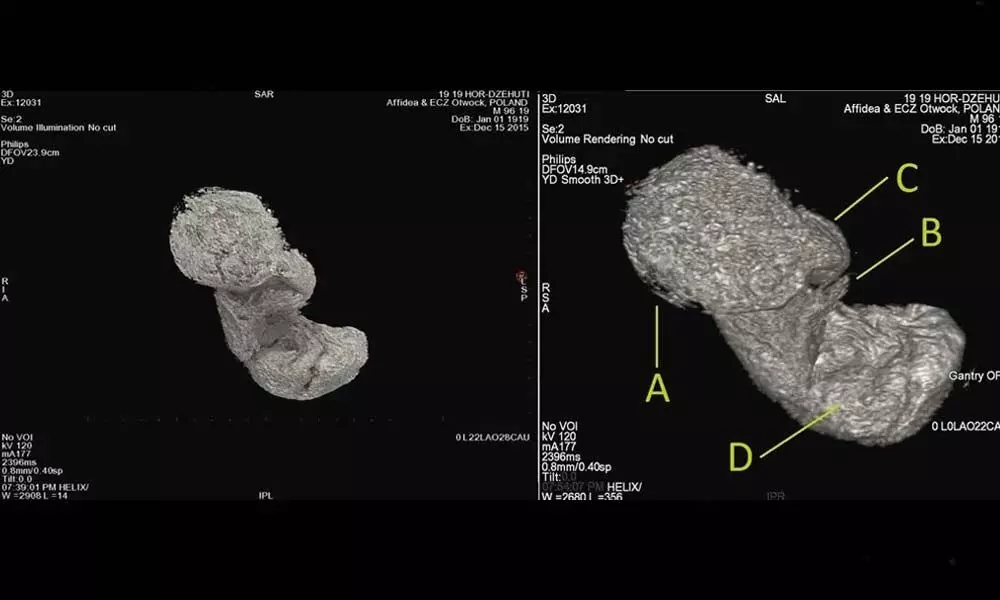Live
- They always want me to win, and now I feel lucky to have been offered a story like ‘Zebra’: Satyadev Kancharana
- ‘Democracy first, humanity first’: PM Modi in Guyana's parliament on two countries' similarities
- PKL Season 11: Telugu Titans register third straight win to top standings
- Is Pollution Contributing to Your COPD?
- NASA Unveils Underwater Robots for Exploring Jupiter's Moons
- Additional Central forces arrive in violence-hit Manipur
- AR Rahman and Saira Banu’s Divorce: Legal Insights into Common Issues in Bollywood Marriages
- 82.7 pc work completed in HPCL Rajasthan Refinery area: official
- Curfew relaxation extended in 5 Manipur districts on Friday
- Tab scam prompts Bengal govt to adopt caution over fund disbursement
Just In
Scientists Claim About An Egyptian Mummy's Foetus Which Was Saved Since It 'Pickled'


Volumetric rendering of fetus from CT data with interpretation. (Ejsmond et al., J. Archaeol. Sci., 2022)
- The identity of the woman and how she died little over 2,000 years ago remain a mystery, which is why she is known as the Mysterious Lady.
- The body was filled with natron which is a salt combination gathered from dry lake beds, which severely restricted air and oxygen flow.
For the very first time archaeologists astound for the finding of a mummified foetus inside the abdomen of its preserved ancient Egyptian mother.
The identity of the woman and how she died little over 2,000 years ago remain a mystery, which is why she is known as the Mysterious Lady. However, researchers now understand how the foetus was preserved. The preservation occurred due to the acidity of the woman's body as she disintegrated, according to recent study by the Warsaw Mummy Project.
The research team, led by bio-archaeologist Marzena Ozarek-Szilke of the University of Warsaw in Poland and archaeologist Wojciech Ejsmond of the Polish Academy of Sciences explained that the foetus stayed in the uterus that had not been damaged and proceeded to 'pickle.' It's not the most beautiful analogy, but it gets the point across. The pH of the blood in corpses, including the contents of the uterus, drops dramatically, becoming more acidic, while ammonia and formic acid concentrations rise over time. The body was filled with natron which is a salt combination gathered from dry lake beds, which severely restricted air and oxygen flow. The foetus is contained in a nearly hermetically sealed uterus.
In a response to the initial discovery, radiologist Sahar Saleem of Cairo University in Egypt asked the issue of whether what they had seen was truly a foetus. She pointed out that the mummy's scans revealed no bones, implying that the identification of a foetus was dubious.
In a response to the initial discovery, radiologist Sahar Saleem of Cairo University in Egypt asked the issue of whether what they had seen was truly a foetus. She pointed out that the mummy's scans revealed no bones, implying that the identification of a foetus was dubious. However, as Oarek-Szilke and her team suggest, this is not surprising. Throughout the first two trimesters, foetal bones are very weakly mineralized, making them harder to identify after completing preservation procedures. Even during archaeological investigations, foetal bones are difficult to come by.
Furthermore, the acidifying activities that would have occurred within the Mysterious Lady's corpse as her body disintegrated would have severely dehydrated the extremely fragile embryonic bones. It's analogous to the natural process of mummification found in peat bogs, in which the very acidic environment 'pickles' soft tissue while demineralizing the bones.
The Mysterious Lady's body and the fetus's flesh are distinct in this sense since they were preserved uniquely. The Lady was mummified with natron, a found naturally salt mixture utilised by the ancient Egyptians to dry and disinfect their remains. In the resultant acidic atmosphere, the foetus mummified in her confined womb.
Furthermore, minerals leached from the foetus' bones would have been stored in the foetus' soft tissues, as well as the uterus surrounding it, resulting in a higher-than-expected mineral concentration which indicates that in CT scans, those tissues will have a higher radiodensity.
Other pregnant mummies could be hiding in plain sight in other museum collections, according to the findings. Mummy scans are typically used to locate bones and amulets nestled inside their wrappings. Other mummies of this type could be recognized by examining closely at soft tissues. As a result, archaeologists and anthropologists may be able to figure out why the foetus was preserved when the Mysterious Lady's other internal parts were removed for mummification.
The mother did not die in childbirth, according to the team's investigation, due to the position of the foetus and the restricted status of the birth canal. The Mysterious Lady was around the ages of 20 and 30 when she passed, and her pregnancy was between 26 and 30 weeks, according to previous research. They can resurrect the memories of the Mysterious Lady and the unborn child by analysing her.

© 2024 Hyderabad Media House Limited/The Hans India. All rights reserved. Powered by hocalwire.com






